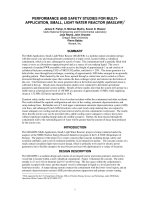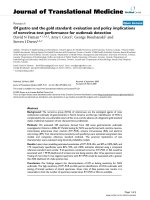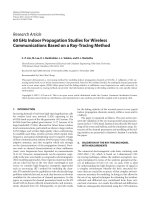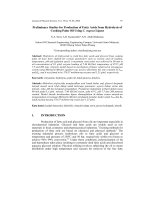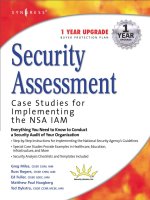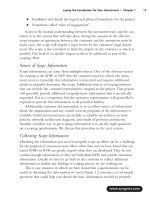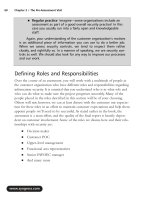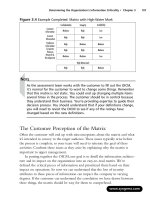Case-Control Studies for Outbreak Investigations
Bạn đang xem bản rút gọn của tài liệu. Xem và tải ngay bản đầy đủ của tài liệu tại đây (331.48 KB, 46 trang )
<span class="text_page_counter">Trang 1</span><div class="page_container" data-page="1">
Case-Control Studies for Outbreak Investigations
</div><span class="text_page_counter">Trang 2</span><div class="page_container" data-page="2"><small></small>
Describe the basic steps of conducting a case-control study
<small></small>
Discuss how to select cases and controls
<small></small>
Discuss how to conduct basic data analysis (odds, odds ratios, and matched analysis)
<small></small>
Provide examples of recent outbreak
investigations that have used the case-control study design
</div><span class="text_page_counter">Trang 3</span><div class="page_container" data-page="3">Quick Review of
Case-Control Studies
<small></small>
Analytic studies answer “what is the
relationship between exposure and disease?”
<small></small>
Case-control design often conducted with relatively few diseased individuals (so is efficient)
<small></small>
Case-control design useful when studying a rare disease or investigating an outbreak
</div><span class="text_page_counter">Trang 4</span><div class="page_container" data-page="4">Case Selection
<small></small>
Depends on how the study investigator defines a case
<small></small>
Case definition: “a set of standard criteria for deciding whether an individual should be
classified as having the health condition of interest”
<small>(1)</small><small></small> Clinical criteria
<small></small> Restricted to time, place, person characteristics
<small></small> Simple, objective, and consistently applied
</div><span class="text_page_counter">Trang 5</span><div class="page_container" data-page="5"><small></small>
Mass screening programs
<small></small>
Case-patients identify other persons who have similar illness
</div><span class="text_page_counter">Trang 6</span><div class="page_container" data-page="6">Case Selection Example
<small></small>
August 2001: Illinois Department of Health notified of a cluster of cases of diarrheal illness associated with exposure to a
recreational water park in central Illinois
<small>(2)</small><small></small>
Local media and community networks used to encourage ill persons to contact the local
health department
<small></small>
Case-patients asked if there were any other ill persons in their household or if anyone
attending the water park with them was ill
</div><span class="text_page_counter">Trang 7</span><div class="page_container" data-page="7">Control Selection
<small></small>
Most difficult part of a case-control study!
<small></small>
We would like to be able to conclude that there is an association between exposure and disease in question
<small></small>
Way the controls are selected is major determinant of whether this conclusion is valid
<small>(3)</small></div><span class="text_page_counter">Trang 8</span><div class="page_container" data-page="8">Control Selection
<small>(1)</small><small></small>
Controls are persons who do not have the disease in question
<small></small>
Should be representative of population from which cases arose (source population)
<small></small>
If a control had developed the disease, would have been included as a case in the study
<small></small>
Should provide good estimate of the level of exposure one would expect in that population
</div><span class="text_page_counter">Trang 9</span><div class="page_container" data-page="9">Control Selection
<small></small> Sources for controls:
<small>Same health-care institutions or providers as cases</small>
<small>Same institution or organization as cases (e.g., schools, workplaces)</small>
<small>Relatives, friends, or neighbors of cases</small>
<small>Randomly from the source population (1)</small>
<small></small> May choose multiple methods of control selection
<small></small> Source will depend on the scope of the outbreak
<small></small> May choose multiple controls per case to increase likelihood of identifying significant associations (usually no more than 3 controls per case)
</div><span class="text_page_counter">Trang 10</span><div class="page_container" data-page="10">Control Selection Example
<small></small>
Persons served by the same health-care institution or providers as the cases
<small></small> August 2001: cluster of Ralstonia pickettii
bacteremia among neonatal intensive care unit (NICU) infants at a California hospital <small>(4)</small>
<small></small> Controls were NICU infants who:
<small>1.Had blood cultures taken during either cluster period (July 30-August 3 and August 19-30);</small>
<small>2.Had blood cultures that did not yield R. pickettii; and </small>
<small>3.Had been in the hospital for at least 72 hours. </small>
<small></small> Attempted to recruit 2 controls per case-patient
</div><span class="text_page_counter">Trang 11</span><div class="page_container" data-page="11">Control Selection Example
<small></small>
Members of the same institution or organization
<small></small> 2004: outbreak of varicella in a primary school in a suburb of Beijing, China <small>(5)</small>
<small></small> Case-control study to identify factors contributing to high rate of transmission and assess
effectiveness of control measures
<small></small> Controls included randomly-selected students in grades K-2 of the primary school with no history of current or previous varicella
<small></small> One control recruited for each case-patient
</div><span class="text_page_counter">Trang 12</span><div class="page_container" data-page="12">Control Selection Example
<small></small>
Relatives, friends, or neighbors
<small></small> August 2000: increase noted in Salmonella serotype Thompson isolates from Southern
California patients with onset of illness in July <small>(6)</small>
<small></small> Preliminary interviews found many case-patients had eaten at Chain A restaurant in 5 days before illness onset
<small></small> Case-control study conducted to evaluate specific food and drink exposures at Chain A restaurants
<small></small> Controls were well friends or family members who shared meals with cases at Chain A during
exposure period
</div><span class="text_page_counter">Trang 13</span><div class="page_container" data-page="13">Control Selection Example
<small></small>
Random sample of the source population
<small></small> January-June 2004: aflatoxicosis outbreak in eastern Kenya resulted in 317 cases and 125 deaths <small>(7)</small>
<small></small> Case-control study conducted to identify risk factors for contamination of implicated maize
<small></small> Randomly selected 2 controls from each case patient’s village
<small>Spun a bottle in front of village elder’s home and walked to fifth house in direction indicated by the bottle (or third house in sparsely populated areas)</small>
<small>Random number list was used to select one household member</small>
</div><span class="text_page_counter">Trang 14</span><div class="page_container" data-page="14">Control Selection Example
<small></small>
Multiple methods of control selection
<small></small>
In waterpark outbreak in Illinois previously mentioned, recruited 1 control per case
using 3 methods
<small>(2)</small><small></small> Case-patients asked to identify another healthy person
<small></small> Used local reverse-telephone directory based on residential address of case-patients
<small></small> Canvassed local schools and community groups
</div><span class="text_page_counter">Trang 15</span><div class="page_container" data-page="15">Selection Bias
<small></small>
Bias: distortion of relationship between exposure and disease
<small></small>
Systematic difference in way you select your controls compared to way you select your
cases that could be related to the exposure could introduce bias
<small></small>
Bias related to the way cases or controls are chosen for a study is ‘selection bias’
</div><span class="text_page_counter">Trang 16</span><div class="page_container" data-page="16">Selection Bias Example
<small></small>
Case-patients more likely to work on lower floors of an office building and employees on the lower floors are more likely to leave the building to go out for lunch
<small></small>
If control population is mostly employees from upper floors, conclude there is a real difference between cases and controls
associated with eating at a local deli
<small></small>
But the difference is due to where they
worked in the building, which resulted in how often they ate out
</div><span class="text_page_counter">Trang 17</span><div class="page_container" data-page="17">Selection Bias Example
<small></small>
Outbreak at a gym and a majority of the case-patients are females
<small></small>
Majority of the controls are male
<small></small>
Found an association between illness and an aerobics class
<small></small>
Outbreak was caused by the steam in the sauna in the women’s locker room
<small></small>
Relationship between illness and the aerobics class due to the fact that women are more likely to take an aerobics class than men
</div><span class="text_page_counter">Trang 18</span><div class="page_container" data-page="18"><small></small>
Validity is dependent on the similarity of
cases and controls in all respects except for exposure
<small></small>
“Match” cases and controls on characteristics like age and gender
<small></small> Matching factors should be important in disease development, but not the exposure under
<small></small> Since matching variable will not be associated with either case or control status, it cannot confound, or distort, the exposure-disease association.
<small></small>
Analysis of data must take matching into account
</div><span class="text_page_counter">Trang 19</span><div class="page_container" data-page="19"><small></small> Individual matching (aka matched pairs)
<small>Matches each case with a control that has specific characteristics in common with the case</small>
<small>Used when each case has unique and important characteristics</small>
<small></small> Group matching (aka frequency matching, category matching)
<small>Proportion of controls with certain characteristics to be identical to the proportion of cases with these same characteristics</small>
<small>Requires that all cases be selected first so investigator knows the proportions to which the controls should be matched</small>
<small>If 30% of cases were male, would select so that 30% of controls were male</small>
</div><span class="text_page_counter">Trang 20</span><div class="page_container" data-page="20"><small></small>
Can be time efficient, cost effective, and improve statistical power
<small></small>
The more variables that are chosen as
matching characteristics, the more difficult it is to find a suitable control to match to the case
<small></small> Once a variable is used for matching, no relationship can be discerned between this variable and the disease
<small></small>
Don’t match on anything you think might be a risk factor!
</div><span class="text_page_counter">Trang 21</span><div class="page_container" data-page="21">Individual Matching Example
<small></small>
Outbreak of tularemia in Sweden in 2000
<small>(8)</small><small></small>
Selected two controls for each case
<small></small>
Matched for age, sex, and place of residence
<small></small>
Identified through computerized Swedish National Population Register (stores name, date of birth, personal identifying number, address of all citizens and residents)
</div><span class="text_page_counter">Trang 22</span><div class="page_container" data-page="22">Group Matching Example
<small></small>
Outbreak of Escherichia coli associated with petting zoo at 2004 North Carolina State Fair
<small>(9)</small><small></small>
Recruited 3 controls for each case
<small></small>
Group-matched by age groups (1-5 years, 6-17 years, and 18 years and older)
<small></small>
Identified from list provided by fair officials of 23,972 persons who purchased tickets to the fair online, at kiosks, or in
malls
</div><span class="text_page_counter">Trang 23</span><div class="page_container" data-page="23">Conducting the Investigation
<small></small>
Gather demographic information and exposure histories from cases and
<small></small>
After you have collected the data you need, you can begin the analysis and calculate measures of association
</div><span class="text_page_counter">Trang 24</span><div class="page_container" data-page="24">Analyzing the Data
<small></small>
Odds ratio is calculated to measure the association between an exposure and a disease outcome
</div><span class="text_page_counter">Trang 25</span><div class="page_container" data-page="25">Calculating Odds
<small></small>
Odds measure occurrence of an event compared to non-occurrence of same event
<small></small>
Variables with two levels (binary
variables) used to calculate an odds ratio
<small></small>
Examples of binary variables: yes/no responses (disease/no disease,
exposed/not exposed)
</div><span class="text_page_counter">Trang 26</span><div class="page_container" data-page="26">Calculating Odds
<small></small>
<b>Odds of exposure among cases </b>
calculated by dividing number of
exposed cases by number of unexposed cases
<small></small>
<b>Odds of exposure among controls </b>
calculated by dividing number of exposed controls by number of unexposed controls
</div><span class="text_page_counter">Trang 27</span><div class="page_container" data-page="27">An Odd Measure – How are odds different from probability or risk?
<small>In a bag containing 20 poker chips: 4 red and 16 blue…</small>
<small></small> <b><small>Probability is the number of times something occurs divided </small></b>
<small>by the total numberof occurrences</small>
<small>Probability of getting red is 4/20 (or 1/5 or 20%)Probability of getting blue is 16/20 (or 4/5 or 80%).</small>
<small></small> <b><small>Odds are the number of times something occurs divided by the </small></b>
<small>number of times something does not occur</small>
<small>Odds of getting red are 4/16 (or 1/4)Odds of picking blue are 16/4 (or 4/1)</small>
<small>May refer to the odds of getting blue as 4 to 1 against getting red</small>
</div><span class="text_page_counter">Trang 28</span><div class="page_container" data-page="28">Calculating Odds
<small></small>
A 2x2 table shows distribution of cases and controls:
</div><span class="text_page_counter">Trang 29</span><div class="page_container" data-page="29">Calculating Odds Ratios
<small></small>
Odds ratio is odds of exposure among cases divided by odds of exposure
among controls
<small></small>
Exposure among cases is compared to exposure among controls to assess if
and how exposure levels differ between cases and controls
</div><span class="text_page_counter">Trang 30</span><div class="page_container" data-page="30">Calculating Odds Ratios
<small></small>
Odds ratio calculated by dividing odds of exposure among cases (a/c) by odds of exposure among controls (b/d)
<small></small>
Numerically the same as dividing the products obtained when multiplying
diagonally across the 2x2 table (ad/bc)
<small></small>
Also known as “cross-products ratio”
</div><span class="text_page_counter">Trang 31</span><div class="page_container" data-page="31">Calculating Odds Ratios
<small></small>
To interpret odds ratio, compare value to 1:
<small></small> If odds ratio = 1: odds of exposure is the same
for cases and controls (no association between disease and exposure)
<small></small> If odds ratio > 1: odds of exposure among cases is greater than among controls (a positive
association between disease and exposure)
<small></small> If odds ratio < 1: odds of exposure among cases is less than among controls (a negative, or
protective, association between disease and exposure)
</div><span class="text_page_counter">Trang 32</span><div class="page_container" data-page="32">Calculating Odds Example
<small></small>
Outbreak of Hepatitis A among patrons of a single Pennsylvania restaurant
<small>(10)</small><small></small>
240 case-patients and 134 controls identified
</div><span class="text_page_counter">Trang 33</span><div class="page_container" data-page="33">Matched Analysis
<small></small> If individual matching, 2x2 table set up differently
<small></small> Examine pairs in table, so have cases along one side and controls along the other, and each cell in the
table contains pairs
</div><span class="text_page_counter">Trang 34</span><div class="page_container" data-page="34">Matched Analysis
<small></small> Cell e contains number of matched case-control pairs where both case and control were exposed
<small>Concordant cell (and cell h) because case and control have same exposure status</small>
<small></small> Cell f contains number of matched case-control pairs where cases were exposed but controls were not
<small>Discordant cell (as cell g) because case and control have different exposure status</small>
<small></small> Only discordant cells give useful data: the matched odds ratio calculated as cell f divided by cell g
<b>Matched Odds Ratio = f/g</b>
</div><span class="text_page_counter">Trang 35</span><div class="page_container" data-page="35">Odds vs. Risk
<small></small> Odds are qualitatively different from risk (calculated in a cohort study)
<small></small> Case-control studies select participants based on disease status and then measure exposure among the participants
<small>Can only approximate risk of disease given exposure</small>
<small>Values needed to calculate risk are not available because entire population at risk is not included in the study</small>
<small>Finding and accessing all who did not get sick would be difficult or impossible</small>
<small></small> Case-control study allows us to use only a subset of controls and calculate the odds ratio as an
estimate of the risk
</div><span class="text_page_counter">Trang 36</span><div class="page_container" data-page="36">Example Case-Control Study:
<small></small> November 1999: children’s hospital notified Fresno County Health Department (California) of 5 cases of
E. coli O157 infections during a 2-week period <small>(11)</small>
<small></small> All case patients had eaten at popular fast-food restaurant chain A in 7-day period before onset of illness
<small></small> Local health officials and clinicians throughout
California asked to enhance surveillance for E. coli
O157 infections
<small></small> States bordering California asked to review medical histories of persons with recent E. coli O157
infections and arrange for subtyping of isolates
<small></small> 2 sequential case-control studies conducted in early December 1999
</div><span class="text_page_counter">Trang 37</span><div class="page_container" data-page="37">Example Case-Control Study:
<small></small> First study conducted to determine the restaurant associated with the outbreak
<small></small> Case defined as patient with:
<small>An infection with the PFGE-defined outbreak strain of E. coli </small>
<small>O157:H7, diarrheal illness with more than 3 loose stools </small>
<small>during a 24-hour period, and/or hemolytic uremic syndrome (HUS) during the first 2 weeks of November 1999; or </small>
<small>Illness clinically compatible with E. coli O157:H7 infection, without laboratory confirmation but with epidemiologic connection to the outbreak</small>
<small></small> Control defined as person without a diarrheal illness or HUS during the first 2 weeks of November 1999
</div><span class="text_page_counter">Trang 38</span><div class="page_container" data-page="38">Example Case-Control Study:
<small></small>
Controls age-matched and systematically
identified using computer-assisted telephone interviewing or residents in the same
telephone exchange area as case patients.
<small></small>
Attempted 2 controls per case
<small></small>
Enrolled 10 cases and 19 matched controls
<small></small>
Only chain A showed statistically significant association with illness among cases and controls
</div><span class="text_page_counter">Trang 39</span><div class="page_container" data-page="39">Example Case-Control Study:
<small></small> Second case-control study involving patrons of chain A restaurants conducted to determine specific menu item or ingredient associated with illness <small>(11)</small>
<small></small> Case defined as above but restricted to those who
had eaten at chain A and who could be matched with “meal companion-controls”
<small></small> 8 cases and 16 meal companion-controls enrolled
<small></small> Consumption of a beef taco was found to be statistically associated with illness
<small></small> Traceback investigation implicated an upstream supplier of beef, but farm investigation was not possible
</div><span class="text_page_counter">Trang 40</span><div class="page_container" data-page="40">Example Case-Control Study:
Listeriosis with deli meat
<small></small> July and August 2002: 22 cases of listeriosis were reported in Pennsylvania, a nearly 3-fold increase over baseline <small>(12)</small>
<small></small> Subtyping identified cluster of cases caused by single
Liseteria monocytogenes strain
<small></small> CDC asked health departments in northeast United States to conduct active case finding, prompt
reporting of listeriosis cases and retrieval of clinical isolates for rapid PFGE testing
<small></small> Conducted case-control study to identify cause of increase in cases
</div><span class="text_page_counter">Trang 41</span><div class="page_container" data-page="41">Example Case-Control Study:
Listeriosis with deli meat
<small></small> Case-patient defined as person with
culture-confirmed listeriosis between July 1 and November 30, 2002, whose infection was caused by the
outbreak strain
<small></small> Control defined as person with culture-confirmed listeriosis between July 1 and November 30, 2002, whose infection was caused by any other
non-outbreak strain of L. monocytogenes, and who lived in a state with at least 1 case patient
<small></small> Interviewed with standard questionnaire including more than 70 specific food items to gather medical and food histories during the 4 weeks preceding culture for L. monocytogenes.
</div>
